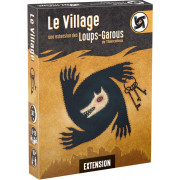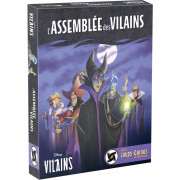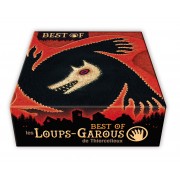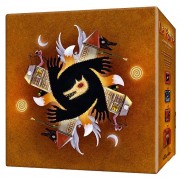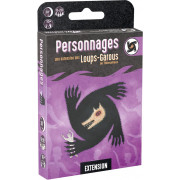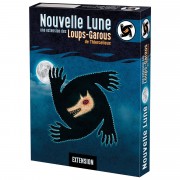Les Loups-Garous de Thiercelieux

Werewolves in few words
Les Loups-Garous de Thiercelieux is a party game based on an asymmetrical hidden-role system in which each player takes on a role of his or her own. The villagers aim to unmask and kill the werewolves, while the werewolves try to keep their identity secret and kill the villagers.
The origins of the game
This game was inspired by Mafia, a game created in 1986 by Dimitri Davidoff, a psychology professor at Moscow University. The aim of the game was to find out whether an informed minority could defeat an uninformed majority. After a successful run at other Soviet universities and schools, Mafia spread abroad, first to Europe, then to the USA, where American Andrew Plotkin wrote the rules for the game, adding a werewolf theme. The game was named Werewolf in 1997.
Werewolves arrive in Thiercelieux
Among the various variants of these earlier versions, one was an unexpected success. This was Les Loups-Garous de Thiercelieux, released in 2001 and created by Philippe des Pallières and Hervé Marly. With over 5 million copies sold since its launch, the game has touched several generations of players, and is now one of the must-have games of modern board gaming.
The name of the game is a reference to the place of Thiercelieux in the Seine-et-Marne region, where Philippe des Pallières lived.
However, there was no reason to expect such success, as the game struggled to find a publisher. Faced with this lack of interest, Philippe des Pallières decided to set up his own publishing house, Lui-même, and self-publish his game.
Les Loups-Garous de Thiercelieux is now part of the Asmodée catalog.
The birth of a range
Over the years, other boxes have appeared, each introducing new elements to the initial universe. Here are the various boxes that complete the basic game:
2006: Nouvelle Lune, the first expansion.
2009: Le Village, including three new characters and buildings.
2012: Personnages, incorporating new werewolves.
2014 : Le Pacte, bringing together all the boxes in the collection.
Towards popular culture
Les Loups-Garous de Thiercelieux has gradually moved out of the gaming sphere and into pop culture. In 2024, the game was the subject of two adaptations. The first took the form of a film broadcast on the Netflix platform. Entitled Loup-Garous, the film was directed by François Uzan and stars Jean Reno, Franck Dubosc and Suzanne Clément.
The second, closer to the game, is a show on Canal+ featuring comedians such as Panayotis Pascot, Fary and Mister V.
- Grid display
- List display
-
Les Loups-Garous de Thiercelieux- Le Village
9,95 €
Werewolves of Thiercelieux - The Village is an expansion for the popular Werewolves of Thiercelieux game, which adds new gameplay options.
- French
- From 10 years old
- 0 to 10 player(s)
- 30mn to 1h
9,95 €
Vendu par Philibert
-
L'Assemblée des Vilains : Un Jeu Loups-Garous
12,95 €
The Gathering of Villains is an adaptation of the Werewolves of Thiercellieux to the Villains of the Disney universe.
- French
- From 10 years old
- 0 to 10 player(s)
- less than 30mn
12,95 €
Vendu par Philibert
-
Loups-Garous de Thiercelieux Best Of
18,95 €
Carefully selected by their authors, (re) discover the most famous characters of "Loups-Garous of Thiercelieux", "New Moon" and "Characters"!
- French
- From 10 years old
- 0 to 10 player(s)
- less than 30mn
18,95 €
Vendu par Philibert
-
Le Pacte des Loups-Garous de Thiercelieux
32,50 €
Le Pacte des Loups-Garous de Thiercelieux is a boxed set bringing together for the first time the games in the range: Les Loups-Garous de Thiercelieux, Nouvelle Lune, Le Villag...
- French
- From 8 years old
- 0 to 10 player(s)
- less than 30mn
32,50 €
Vendu par Philibert
-
Les Loups-Garous de Thiercelieux - Extension Personnages
9,95 €
The Characters expansion transforms the Werewolves of Thiercelieux! Players will discover 16 new characters that will change the way they play.
9,95 €
Vendu par Philibert
-
Red price
Loups-Garous de Thiercelieux - Extension Nouvelle Lune
9,95 €
New Moon is the first expansion for the Werewolves of Thiercelieux game. Five new characters appear: the village idiot, the elder, the scapegoat, the savior and the piper.
- From 10 years old
- 0 to 10 player(s)
- 1 to 2h
9,95 €
Vendu par Philibert
-
Les Loups-Garous de Thiercelieux
9,95 €
In the wild east, the small hamlet of Thiercelieux has fallen prey to werewolves. In Werewolves of Thiercelieux, the villagers, who have decided not to let themselves be preyed ...
- French
- From 10 years old
- 0 to 10 player(s)
- 30mn to 1h
9,95 €
Vendu par Philibert
Copyright © 2025 www.philibertnet.com Legals - Privacy Policy - Cookie Preferences - Sitemap

